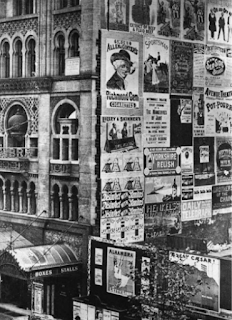pg. 7 - 'Art is man's creation, yet words and pictures are also the form of his language'
'If art is not primarily communication but creation, then posters, with their prescribed function of advertising and propaganda, would seem to be only a secondary art form'
'...Translating the visual art movements of the twentieth century into consumer media'
pg. 8 - '...Technically one can trace the poster's evolution through the printed page'
Théâtre de l'Opéra, Carnaval 1894, Jules Chéret
pg. 12 - 'This is the reason Chéret has become known as the first name in posters. It is not that his designs are masterpieces of the art of advertising, but that is posters, over a thousand of them, are magnificent works of art.
Instead of re-interpreting the great murals of the past for the public of his day by creating large salon canvases, he found a new place for his work - the street.'
'Chéret's posters appeared as a new vital art form'
'Writers like Joris-Karl Huysmans and Edmond de Goncourt, as well as countless critics and art-historians of the time, have drawn attention to the explosion of colour created by Chéret'
'It is because of the material success of this public display of fine art that posters become known as the art gallery of the street'
pg. 16 - 'His posters bring together a traditional technique and appreciation of great mural art, but also that essential ingredient - the feel of the popular idiom.'
Alhambra Theatre, Leicester Square
London, 1899 (Aerofilms)
Posters and SymbolismLondon, 1899 (Aerofilms)
pg. 48 - '...Symbolist art affected poster design by reintroducing iconography as a pictorial element.'
'To the nineteenth century, with its veneers of propriety, it was possible to say something of those areas of human experience that were generally left to the imagination'
pg. 61 - Referencing Hippy Posters - 'In presenting a confused pattern - which may seem a contradictory element when dealing with communications - the artist is saying 'enjoy - let the effect ride over you - through you - use it - live it'
pg. 64 - 'This is the key to many poster designs of the 1960s - from the commercial posters advocating the 'consumer society' way of life at one end of the scale to the posters that suggest 'Love' or 'Peace' as a philosophy.'
Hawaii Pop Rock Festival, 1967
Victor Moscoso
Victor Moscoso
'Many of these designs rely on a sensuous appeal, and represent a break in the attitude that had been built up during the previous decades when the designer developed techniques of delivering clear, concise messages.'
'In the 1960s the general public developed a technique of seeing without reading - even hearing without really listening. It is very much an attitude of mind: the messages come across through the senses generally.'
'In this way the Hippy poster is used to create an environment - in itself another manifestation of total art'
pg. 65 - 'The Hippy poster has a more wide-spread effect because of the technical revolution in printing: the development of typesetting machines and the use of offset lithography.'
Peace (1967), Loren Rehbock
'This has made possible the mass-production of colour work and low-key black and white photographic posters on a large scale.'
'Heroes such as Che Guevara share the privacy of the domestic wall with W.C. Fields, designs by Beardsley and the posters of Toulouse-Lautrec. Mucha and Steinlein have reappeared alongside images of Marlene Dietrich, Brigitte Bardot and Karl Marx, together with many anonymous girls posing in the manner already established by Felicien Rops and others.'
pg. 67 - 'This constant bombardment of the senses has had the effect of producing a conditioned public whose tastes in visual experience are sophisticated'





No comments:
Post a Comment